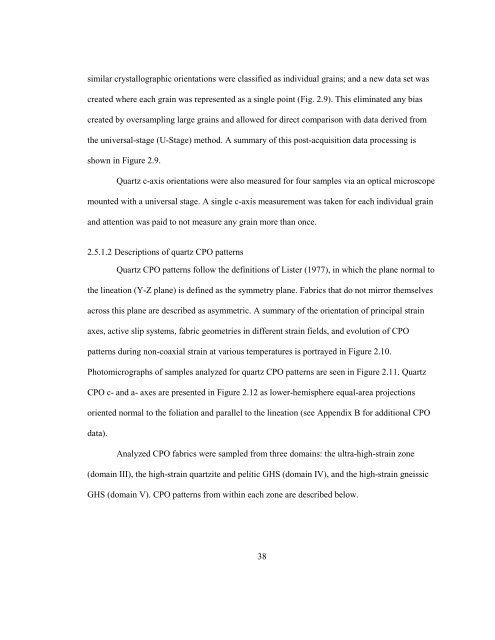title of the thesis - Department of Geology - Queen's University
title of the thesis - Department of Geology - Queen's University
title of the thesis - Department of Geology - Queen's University
Create successful ePaper yourself
Turn your PDF publications into a flip-book with our unique Google optimized e-Paper software.
similar crystallographic orientations were classified as individual grains; and a new data set was<br />
created where each grain was represented as a single point (Fig. 2.9). This eliminated any bias<br />
created by oversampling large grains and allowed for direct comparison with data derived from<br />
<strong>the</strong> universal-stage (U-Stage) method. A summary <strong>of</strong> this post-acquisition data processing is<br />
shown in Figure 2.9.<br />
Quartz c-axis orientations were also measured for four samples via an optical microscope<br />
mounted with a universal stage. A single c-axis measurement was taken for each individual grain<br />
and attention was paid to not measure any grain more than once.<br />
2.5.1.2 Descriptions <strong>of</strong> quartz CPO patterns<br />
Quartz CPO patterns follow <strong>the</strong> definitions <strong>of</strong> Lister (1977), in which <strong>the</strong> plane normal to<br />
<strong>the</strong> lineation (Y-Z plane) is defined as <strong>the</strong> symmetry plane. Fabrics that do not mirror <strong>the</strong>mselves<br />
across this plane are described as asymmetric. A summary <strong>of</strong> <strong>the</strong> orientation <strong>of</strong> principal strain<br />
axes, active slip systems, fabric geometries in different strain fields, and evolution <strong>of</strong> CPO<br />
patterns during non-coaxial strain at various temperatures is portrayed in Figure 2.10.<br />
Photomicrographs <strong>of</strong> samples analyzed for quartz CPO patterns are seen in Figure 2.11. Quartz<br />
CPO c- and a- axes are presented in Figure 2.12 as lower-hemisphere equal-area projections<br />
oriented normal to <strong>the</strong> foliation and parallel to <strong>the</strong> lineation (see Appendix B for additional CPO<br />
data).<br />
Analyzed CPO fabrics were sampled from three domains: <strong>the</strong> ultra-high-strain zone<br />
(domain III), <strong>the</strong> high-strain quartzite and pelitic GHS (domain IV), and <strong>the</strong> high-strain gneissic<br />
GHS (domain V). CPO patterns from within each zone are described below.<br />
38

















